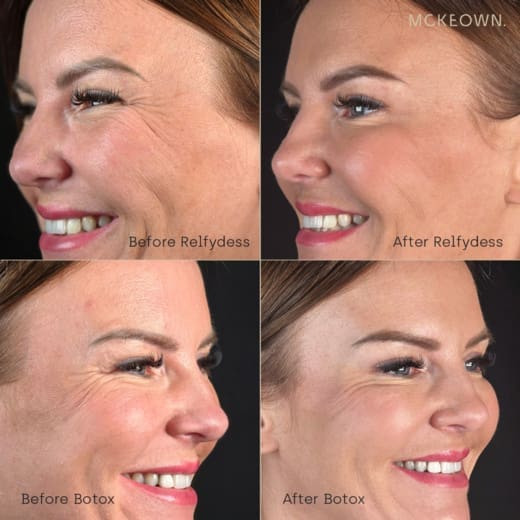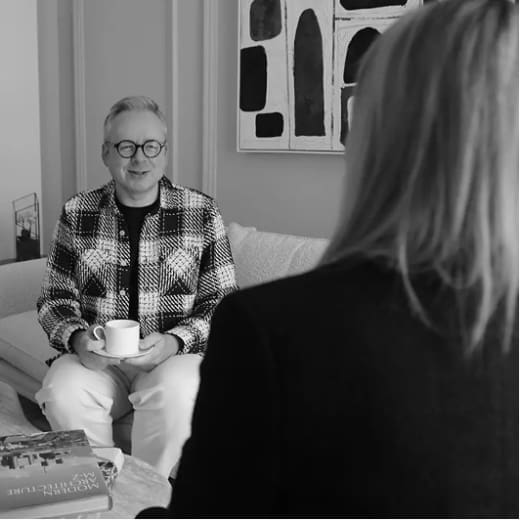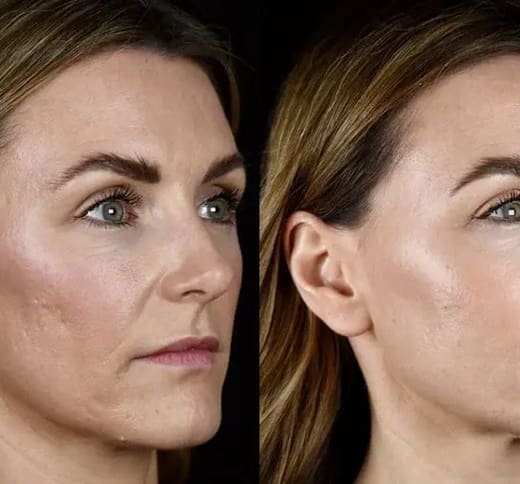McKeown Medical
167 Bath Street, Glasgow, G2 4SQ
Date posted — 13.08.24
Sun damage is, as the name suggests, changes to the skin due to long term exposure to the sun’s UV radiation.
And as the word ‘damage’ suggests, these are not positive changes.
These are changes to the structure and function of the skin that are initially visible in the way the skin looks and can eventually become severe enough that cancer cells start to develop.
So sun damage is a real problem, and something we should all take seriously.
If you think about the skin on a baby or a toddler and what it looks like, it’s usually quite pale, even in colour and smooth in texture.
Of course, this starts to change through the teenage years and the onset of puberty when the skin can become thicker with more sebaceous glands making the skin more oily.
But in general the skin remains relatively light in colour and smooth in texture.
The skin on the face doesn’t tend to stay that youthful dewy way for long.
By the time most people are in their 30s and 40s you can see visible changes have happened to the skin that continue to get worse into the 50s and 60s and beyond.
Almost all the changes we see to our skin as we age are the result of exposure to our environment and by far and away the biggest exposure is to the sun.
The next biggest environmental exposure is nicotine, although thankfully that is something we are seeing less and less of now.
To a much lesser extent, the changes to the skin we see are the result of environmental pollution and sugar (yes, too much sugar makes the skin look older too).
The first change that we see from sun damage is usually to the pigmentation of the skin.
The production of pigment – melanin – is the skin’s natural defence to protect our DNA from the harmful effects of the sun’s UV radiation.
This is the pigment we see when our skin looks tanned.
When we are young, most of us think a tan looks nice, which is why so many of us tan and don’t think about future consequences.
But years of over-production of melanin in our skin makes the mechanism by which we produce it become less well regulated, and so we develop patches of irregular pigmentation – often referred to as age spots, or hyperpigmentation.
The next change that you can see from chronic sun damage is to the vascular system on the face.
When the skin is exposed to the sun, blood is diverted to the skin to help defend it and restore normal function.
In the short term we see this as redness, often referred to as sunburn.
Due to chronic exposure, we eventually develop disregulated blood vessels on the face which cause patches of redness and visible dilated blood vessels, even when the acute effects of the sun have worn off.
This causes redness and thread veins.
The chronic inflammation caused by sun exposure also causes disruption to the collagen and elastin fibres in the deeper layer of the skin – the dermis – which is responsible for giving the skin its physical structure.
Healthy skin has well-organised patterns of collagen and elastin but with chronic sun exposure this becomes more hectic and chaotic.
The disruption of these structural molecules leads to changes to the texture of the skin – roughness, fine lines (rhytids) when the face moves and eventually even when the skin is at rest (static rhytids).
Over time, the elastin fibres can become so disorganised that they form visible little bumps on the skin referred to as ‘elastosis’ or ‘solar elastosis’ to indicate that it is caused by sun exposure.
Eventually the disregulation to the structure and function of the skin leads also to the formation of growths on the skin.
Sometimes these growths can be harmless, but sometimes the growths can become cancerous.
The effects of sun damage on the skin are cumulative – which means that they get worse over time.
I often hear patients tell me that they can’t have sun damage because they wear SPF every day and yet when I look at their skin they have plenty of signs of sun damage.
That’s because they may well take care of their skin now, but they didn’t when they were younger and it’s catching up with them now!

When a new wrinkle-relaxing treatment comes to market, it often generates a lot of buzz but at McKeown Medical, we...

Think varicose vein treatment is painful, risky, or ineffective? Discover the truth as we debunk 5 common myths and reveal...

Struggling with acne scars? We compare microneedling and laser resurfacing to reveal which treatment smooths skin, boosts collagen, and reduces...
1 / 3
2 / 3
3 / 3

When a new wrinkle-relaxing treatment comes to market, it often generates a lot of buzz but at McKeown Medical, we...

Think varicose vein treatment is painful, risky, or ineffective? Discover the truth as we debunk 5 common myths and reveal...

Struggling with acne scars? We compare microneedling and laser resurfacing to reveal which treatment smooths skin, boosts collagen, and reduces...
Fine lines etched into the skin around the mouth - this is a common problem and in this patient`s case she had what we call ‘actinic elastosis’, whereby abnormal bands of elastin build up in the skin as a result of years of previous sun exposure.
When patients have this condition, the gold standard way of dealing with it is fully ablative laser resurfacing. It’s an intense treatment with two weeks of downtime afterwards, but the results are spectacular - just like in this lovely patient.
The after photo is three weeks after the treatment and you can see that the skin is still a little pink, which will continue to fade over the next few months.
The patient is already delighted with the result - what do you think?

It’s beginning to look a lot like Christmas!
At least according to Michael Buble, who’s been on repeat in the clinic this week. The decorations are up and we are officially in ‘our season’. The clinic has been packed with everyone having their skin polished in time to make it on the nice list. If you’ve still to make a pre-Christmas appointment, we’ve still got some spaces left for your festive glow up.
Ho ho ho everyone… It’s time for Santa!!!! 🎅🏻

Ok, so this is the one we’ve all been waiting for. Sofwave : the results, in our hands!!!
This is the first patient we treated with @sofwave.uk when we were assessing the machine and deciding whether or not to buy it. These are the patient`s own photos that she kept throughout the healing journey.
Now do you see why we are so excited?! 🤩
#sofwave
#sofwavemed
#SUPERB
#sofwavemedical
#sofwavejourney
#sofwaveexperience

We are now well up and running with @sofwave.uk , much to the excitement of the whole team in the clinic (we are all queuing up to get a shot!)
This is a little video of the treatment being performed, so you can see what the process is like and there is even a little early preview of the results at the end.
One of the best parts is that there is no downtime, so we can still fit it in before Christmas without worrying about redness in the party season!
What do you think?
#sofwave
#sofwavemed
#SUPERB
#sofwavemedical
#sofwavejourney
#sofwaveexperience

We`re absolutely delighted to introduce you to our lovely new doctor, Dr Sharon.
With over 30 years’ experience as a medical doctor and a decade specialising in aesthetic medicine, Dr Sharon brings exceptional skill, warmth and a deeply patient-centred approach to every treatment.
She joins us with extensive expertise in injectables, including advanced toxin and filler techniques, and will also be leading our regenerative aesthetics offering with Ameela polynucleotides and Ameela Exosomes - two of the most exciting developments in skin rejuvenation. She will also be offering Profhilo and Profhilo Structura!

We have a super exciting new addition to the clinic this week, with the launch of @sofwavemed.
Sofwave is an incredible skin tightening technology that has been around for five years now. I am never first to the queue with new devices because so many don’t deliver and disappear within a couple of years of launch. Sofwave however has continued to grow in popularity over the years and earlier this year I decided I had to find out what all the fuss was about.
I asked the reps to bring it round for us to play with and we treated a few of our patients to see what the results were like and, three months later not only was I signing the purchase order I was asking how quickly I could get one of the reps round to treat me 😊
Sofwave works using ultrasound waves to create a thermal injury to the deeper layers of the skin, initiating a healing response which over a period of several months results in a skin tightening effect.
I have trialled a number of ultrasound devices in the past and have never bought any of them because I was always disappointed in the results. There are a couple of things that I think makes Sofwave different.
First, it only goes to 1.5mm which means all of the energy is being delivered to the skin. Most other devices go down to 3 or 4mm, by which point you are past the skin and into the fat which can, if anything, have a worsening effect on volume loss. The second difference that I think is important is that it treats a bigger proportion of the surface area of the skin.
We have a new page on our website where you can read all about Sofwave and how it works, but for now, enjoy some of these before and afters that the manufacture supplied.
Let me know what you think!

Lower eyelid surgery is one of the more challenging operations in aesthetic practice. If we can avoid it, we normally try to help our patients chose non-surgical paths using laser or fillers.
However, there are some situations where it can’t be avoided, especially when there is excess fat under the eye causing puffiness. This is exactly what this patient had and so the very talented @bramhallplasticsurgery performed an upper and lower blepharoplasty for him. Whilst we often do the upper eyelids without doing the lower eyelids, usually when we do the lower eyelids we always need to do the uppers too.
This patient is now a couple of months out from surgery and loving his result. What do you think?

Laser season continues!
Thank you to this lovely patient who has kindly allowed us to share her results. She was particularly concerned about the fine lines and creases around her mouth, and underwent full-field laser resurfacing to target the deeper layers of the skin.
This is just two months after treatment and you can already see a significant improvement in the fine lines and overall skin texture. She’s still a little red and got some more healing to do, but she is already very happy with the improvement. This patient was a bit anxious about having the treatment done, so chose to have it under sedation which means she slept throughout and woke up when it was over!
What do you think?

It’s been six months since we launched the new toxin Relfydess in the clinic so, how is it going?
We’ve undertaken a survey of all of the patients we treated with the new toxin in the first month, who are now around six months since their first treatment, to find out more about what they thought of the results over the longer term - whether it kicked in faster, whether it looked better and whether they felt it lasted longer than the previous toxin.
Here are the results, and the feedback so far is really encouraging with the majority of patients reporting that it kicked in faster, looked better and lasted longer.
If you’d like to see more detail and analysis of these results, check out the link to the blog post in our profile.
